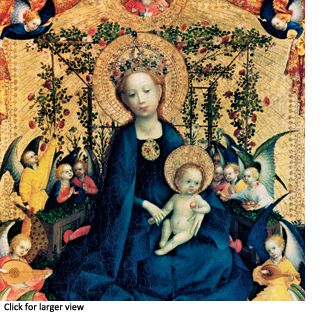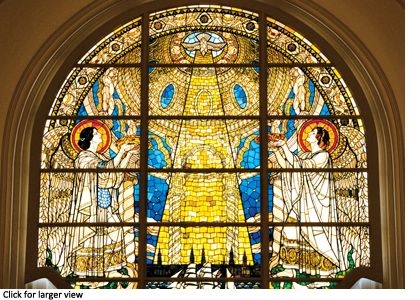Travel to Germany with Angels on Earth

German nun and composer Hildegard von Bingen wrote, “Angels, living light…what glorious pleasures take shape within you!” Hildegard may have lived during the twelfth century, but the angelic influence she wrote about is still shedding light on modern Germany. Tourists and citizens can witness the angels’ “glorious pleasures” in churches, museums and public installations from the Baltic Sea to Bavaria. Angel lovers, Willkommen in Deutschland!
Wallraf-Richartz Museum, Cologne, Germany
Late-Gothic German painter Stefan Lochner sprinkled child angels throughout his creations. Thirteen angels appear in “Madonna of the Rose Bower,” known as the Mona Lisa of Cologne. Foreground angels play instruments and offer gifts, while background angels stretch a curtain behind the Madonna and child. An angel statue holding a painter’s palette was erected in Lochner’s honor in Cologne. Asteroid “12616 Lochner” was named for the artist in 2008, forever cementing his place in the heavens.
St. Michael’s Church, Hamburg, Germany
Parishioners and visitors to the iconic clock tower in Hamburg’s St. Michael’s Church have the chance to admire this stained glass window, titled “God’s Blessing on Hamburg.” The two angels hold up bowls to symbolize the outpouring of God’s love onto the city, and stand on snakes to symbolize the crushing of evil. Installed in 1911, the window was designed by artist August Vogel.
Wendt & Kühn Workshop, Grünhainichen, Germany
Two former Dresden Arts Academy students established the Wendt & Kühn Workshop in 1915. The business, which became famous for its wooden angels, has since grown into a household name around the world. Strict guidelines govern every detail of production, right down to the number of dots on the angels’ wings. Angel collectors who want to know more about these wooden treasures can attend one of the workshop’s open houses.
Did you enjoy this story? Subscribe to Angels on Earth magazine.


